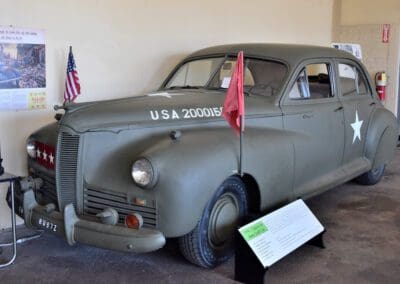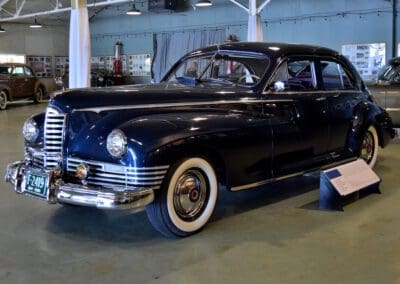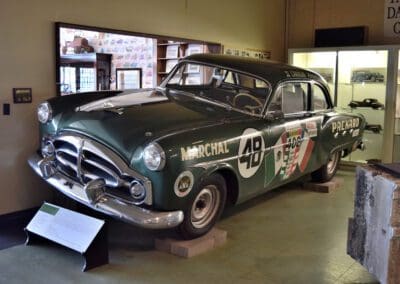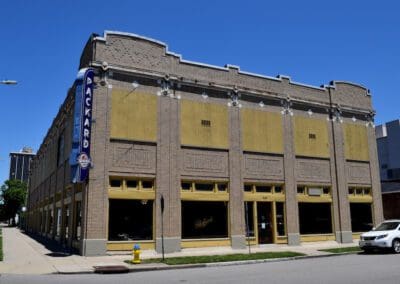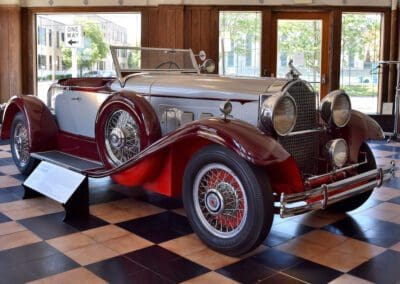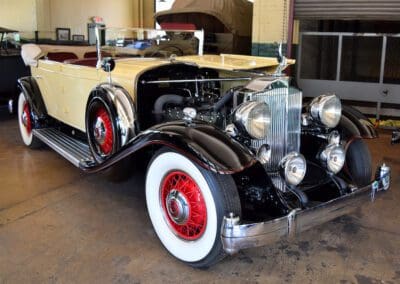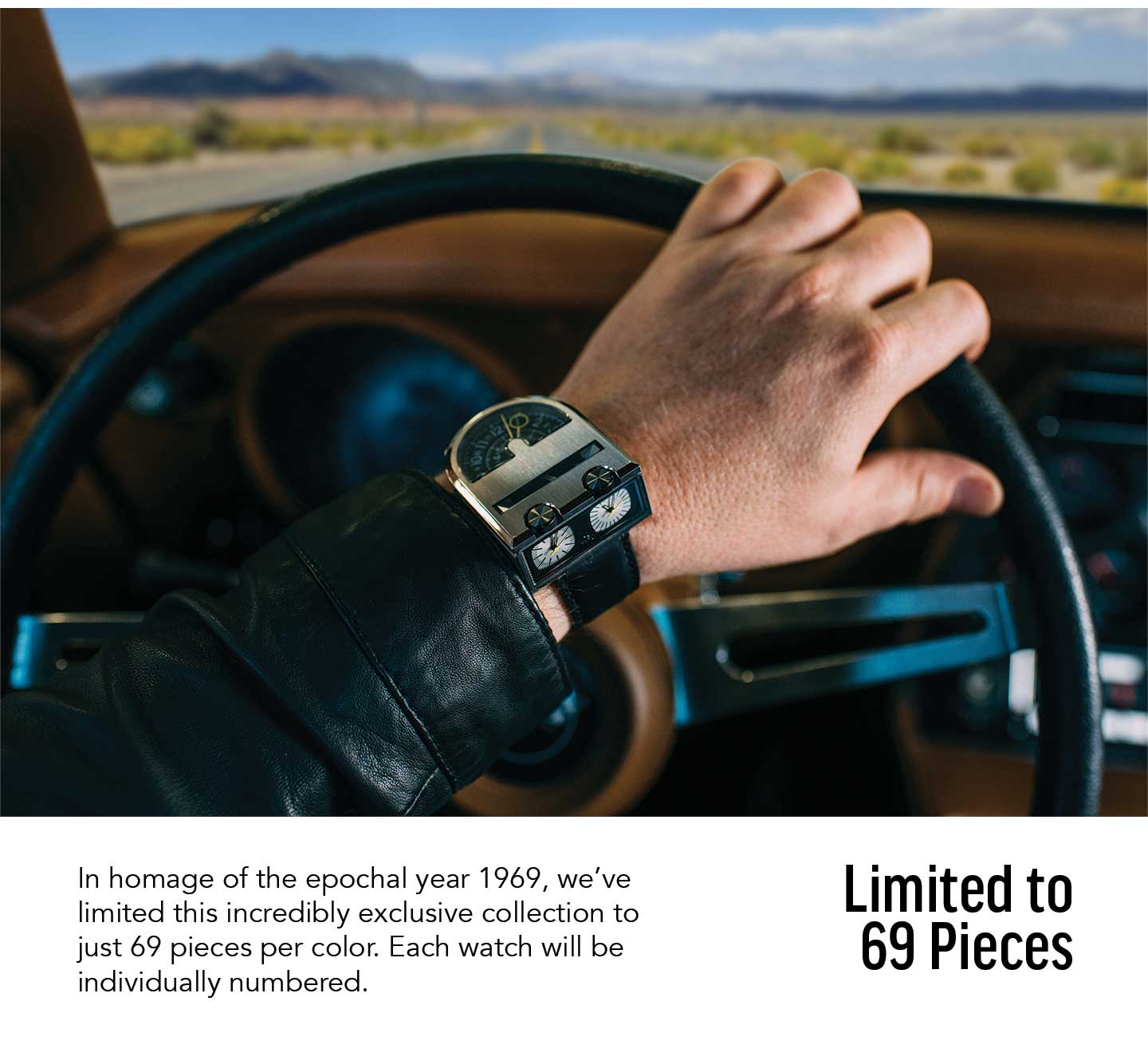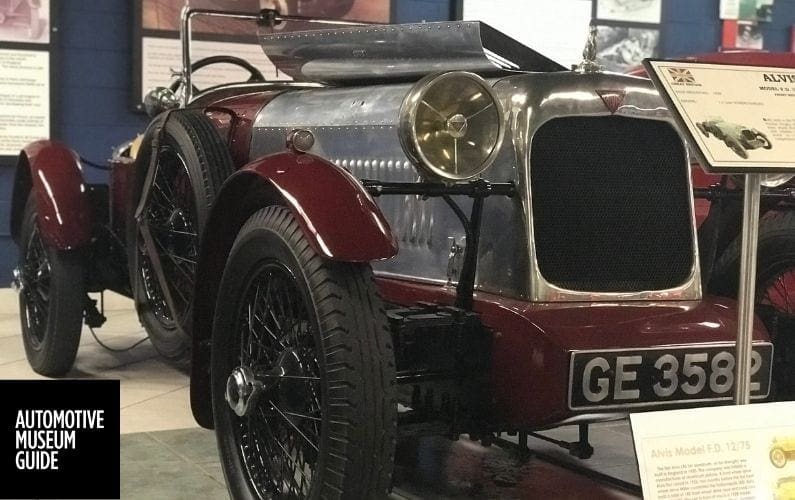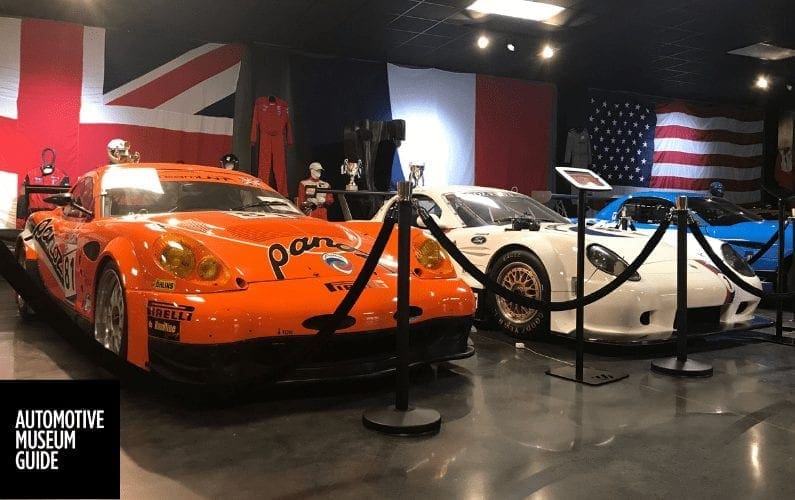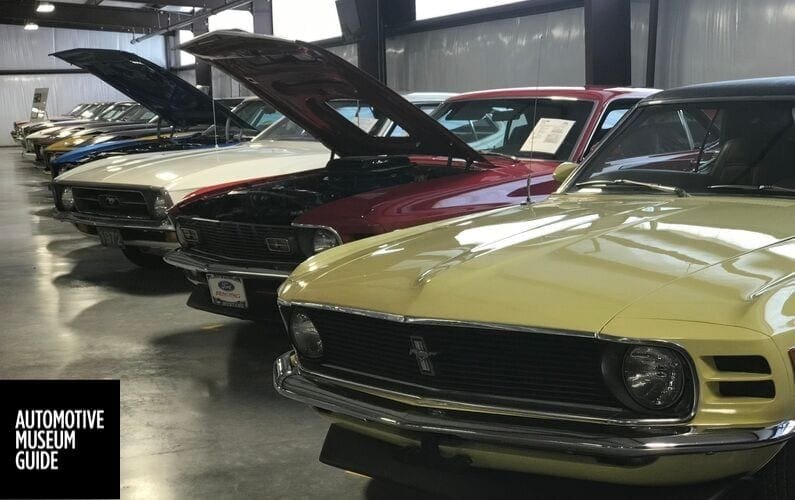A Visit To America’s Packard Museum
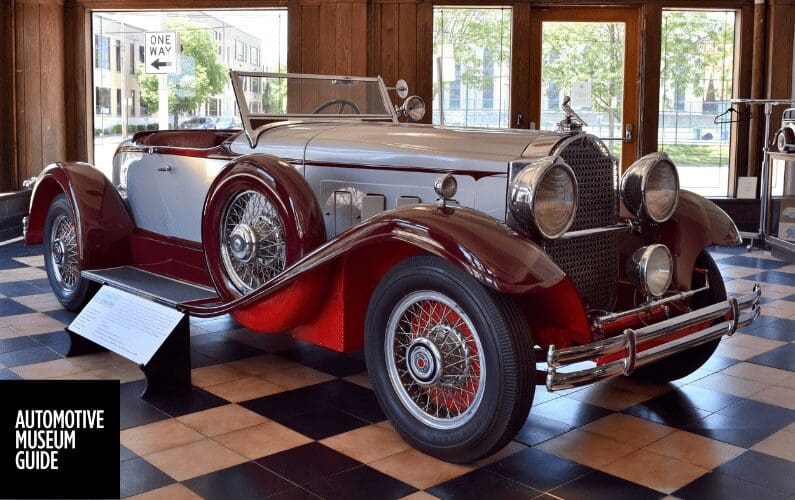
In June 2022 I visited The Citizen’s Motorcar Company, America’s Packard Museum, in Dayton, Ohio. It’s amazing that there are two fine museums devoted to this single-marque in the same state, only four hours’ drive apart. (The other one is the National Packard Museum [NPM] in Warren, home of the Packard brothers.) America’s Packard Museum [APM] says it’s the largest Packard museum in the country.
Back in 2019 when I first read that, I interpreted it as subtle one-upmanship to the National Museum, but the APM founder’s wife told me they aren’t rivals and get along quite well. In fact, at least one of the cars on display during my visit was on loan from the National Packard Museum. APM really is the largest, however, with around 50 vehicles, all but one a Packard product (and the lone exception, a DeLorean, has a Packard connection, as you’ll see below).
The founder and original curator of the museum was Robert E. Signom II, a Dayton attorney with (obviously) a passion for Packards. His first collector car, a 1928 Six Convertible Sedan with his father’s initials on the door, is displayed in the second showroom.
Mr. Signom, who founded the museum in 1992, passed away in 2019 but his son, Robert E. Signom III, is the current curator and his charming wife was working the front desk when we visited. According to a 2010 story in The New York Times on the museum’s website, Robert Signom Jr. started the museum as a tribute to his father, who lost the 1928 Packard in the Great Depression. Not “a” 1928 Packard, “the” 1928 Packard on display.

Mr. Signom II. happened to see a classified ad in The Times for a 1928 Packard while on a business trip to NY and asked his dad if there was a way to identify his former car. The elder Signom had made a small slit in an unobtrusive place in the rear upholstery to accommodate his golf clubs. Sure enough, the Packard for sale had the slit and the son bought the car “for more than I should have,” according to the article.
Unlike the NPM, which focuses a lot on the story of the Packard brothers and the development of their cars, APM mainly is a showcase for the vehicles, with few other artifacts, mostly advertising and signs, on display and all of the information contained in the individual vehicles’ signs.
However, it’s housed in the former Dayton Packard distributor’s facilities with the original (still working) porcelain/ neon sign, which Mr. Signom found in the basement. Buying the building allowed the museum to obtain some original advertising material and signs, and the showroom retains a checkerboard floor and large windows that really set off the pride of the collection on display. Not visible to visitors, but mentioned in The Times article, are working hydraulic lifts and ceiling-mounted hose reels for oil and grease.

The museum also houses the Turnquist Packard Library, named for Packard historian and collector Robert Turnquist and his wife. A number of model and toy cars are displayed in the museum’s collection, including a group of large, vintage pressed steel cars and trucks and another group of models in about 1:24 scale that appears to be made of resin or maybe porcelain.
A nice touch in the informative signs that accompany each car is the cost of the car when it was new compared to the average cost of a car for that year, the average annual income, the cost of a house, and the cost of a gallon of gasoline. A few notable events in the year each car was made also are listed. As you’ll see in the captions to the photos, some of the Packards on display are quite rare, and some were owned by famous (or infamous) people.
Among the cars on display when I visited were:
- 1930 Model 734 Boat-Tail Speedster: Reminiscent of the similar Auburn speedster, the Model 734, which had a top speed of over 100 mph, was made in five body styles but only 150 were produced. The Boat-Tail on display is one of only 11 surviving examples of the total of 39 produced.
- 1953 Pan American: On loan from the National Packard Museum (where I saw it in 2019), this car was designed by Richard Arbib of the Henney Motor Car Company (another example, besides professional cars, of the Henney-Packard collaboration). It was meant to meet the postwar demand for new American sports cars (1953 also saw the debut of the Corvette). The car won awards in America and Europe and was well received, but the very high cost ($11,000 or $115,000 in today’s money) kept it from going into production. Only six were made, of which this is the second.
- 1940 Model 120 Convertible Victoria: Designed by Howard “Dutch” Darrin (who designed the Kaiser Darrin among others), this was a production version of several custom “Packard Darrins” built for Hollywood celebrities after Darrin moved back to the USA from Paris in 1937. The body style is known as a Seneca coupe and was built in 1971 from Darrin’s molds and castings, thus becoming the “last Packard Darrin.”
- 1952 Farina-designed coupe: After Battista “Pinin” Farina’s collaboration with Nash in the early ‘50s, Packard commissioned a design for a unique 1952 coupe from him (his name is on the front quarter panels). The car was never built, but in 1995 a car collector obtained the original plans and had this car built to their specifications. It has a 327 c.i. engine with a three-speed manual transmission.
- 1934 Super Eight Model 1104 Dual Cowl Sport Phaeton: This car was built for the New York Auto Show in a non-standard orange-yellow color called “Orello.” A West Virginia couple bought the car after seeing it at the show for their 16-year-old daughter. The museum said she “hated” the color and found the car difficult to drive (ingrate). This car is unrestored but in excellent driving condition. It cost $3180 compared to $700 for the average cost of a new car in 1934 (or $1600 average annual salary).
- 1928 Six Convertible Sedan: The car that started the museum, Robert E. Signom Senior’s that he lost in the Depression and his son bought many years later in New York, is still in the family and on display. Packard made $21 million in profits in 1928 and beat its main competitor, Cadillac, which introduced the LaSalle line in an effort to compete with Packard’s smaller and less expensive cars that were its best sellers. This was the last year for six-cylinder Packards as the company shifted production to 8- and 12-cylinder cars. This car cost four times the average price of a car in 1928 ($600).
- 1930 Convertible Sedan: With a body by Brewster & Co. of New York (which employed “Dutch” Darrin – see below – until he partnered with Hibbard, another Brewster alumnus). This was one of the most expensive Packards made in 1930, with a $7000 price tag, only $145 less than the average price of a house and ten times the average cost of a car in 1930.
- 1932 Twin Six Convertible Sedan: One of two made with a body designed by the Walter M. Murphy Co. (who also designed cars for Duesenberg) with the “Murphy Disappearing Cowl,” the museum says this style is exceptionally rare. The museum’s car was built for the boat racing champion Gar Wood – the other one was destroyed in a fire in the 1940s.
- 1947 Custom Super Clipper: This car is purported to be the last car Al Capone bought, since he cashed in his chips from syphilis in January 1948, nine years after his release from the federal slammer. By 1946, his doctor and a psychiatrist concluded that he had the mentality of a 12-year-old due to syphilitic paresis, but perhaps he also had a boy’s love for big cars. The museum says his chauffeur/bodyguard, Herman David, a.k.a. “Motorcycle Mike,” used the car until the late 1970s.This car was the last of the Darrin-designed Clippers. The museum’s signage doesn’t identify the owner. I checked this out on the Internet and found a 2015 article in which collector George Holinga claimed he bought the car from Motorcycle Mike in 1979 for $3000 after two years of negotiation (Mike got out of prison in 1977, in his 90s).
However, a post on “Turnerbudds Car Blog” in 2017 included two e-mails from Herman David’s grandson who said the whole story was fiction and his grandfather actually had bought the car for his wife in 1947. He was a friend of Capone’s but not his chauffeur, and had in fact done a long stretch in prison himself (which is why the car was in such good shape).
The grandson found it hard to believe the new owner had swallowed his grandfather’s story. I guess, as the famous line from “The Man Who Shot Liberty Valance” goes, “When the legend becomes fact, print the legend.”
- 1928 Jesse Vincent Speedster: This one-of-a-kind car was driven by Packard’s chief engineer; the company leadership gave him permission to build a car to demonstrate the banked oval track at the new Packard Proving Grounds. Vincent often used the car, which was clocked at a top speed of 129 mph on the track, to commute to work from his home. The famous aviator Charles Lindberg once drove it at 112 mph and remarked that was the fastest he’d ever gone “on the ground.”
- 1918 Model E Army truck: This represents Packard’s sizable contribution to the U.S. war effort in World War I. Packard made trucks from 1905 to 1923; in 1915, Packard made more trucks than cars, supplying many to Allied armies before the United States entered the war. The U.S. Army bought more than 10,000 Packard trucks. The only other truck in the museum is a civilian 1919 Model E 5-ton dump truck that’s accompanied by an ad that seems like a dig at Mack’s A-series chain drive trucks, as it touts Packard trucks’ “silent” chainless drive.
- 1953, ‘55 and ‘56 Caribbean convertibles and a ’56 Caribbean hardtop: The museum said the Caribbean was inspired by the ’52 Pan American and was an attempt to bring the latter car into an affordable range. The ’53 convertible, the first year for the Caribbean with 750 made of all types, was once owned by singer Perry Como.
- 1948 Henny Landau 3-Way Hearse: This hearse was used in the 1972 movie “The Godfather” in the funeral scenes for Marlin Brando’s character Don Vito Corleone. Henney built many professional cars on Packard chassis, and the museum has an “executive sedan” on display next to the hearse. The hearse was called a “3-Way” because caskets could be loaded and unloaded from both sides as well as the rear door.
- 1928 Custom Eight convertible sedan: Another Dutch Darrin design, this was a collaboration with Thomas Hibbard, also formerly of Brewster, in France where they had partnered to make custom cars. This is believed to be one of a kind, and was sold by a Parisian dealer to a customer in Argentina.
- 1951 200 Club Sedan: French racing driver Jean Trevoux (four wins at Monte Carlo before and after WW2) settled in Mexico in the late 1940s and opened a restaurant. He drove several Packards in the grueling week-long Carrera Panamericana road race, including this one. His teenage Mexican mechanic in the 1951 race (in which he placed fifth) restored the car in 1995 with its original equipment and livery, allowing it to enter four more Panamericana vintage races in 1996-1999. (The original race was cancelled in 1955 for safety reasons and resumed under more stringently supervised conditions in 1988 as a vintage car race.) The museum says the car still is actively raced.
- 1950 Station Sedan (not wagon, although most people would call it a station wagon): It looks similar to Chrysler’s Town and Country design. Both the standard production car and a design study with wood trim only above the beltline that didn’t enter production are on display. Packard introduced the car in 1948 and it was the only model that didn’t receive cosmetic changes for 1950.
- 1941 Clipper Six: Many Packards, such as this one in military olive drab, were used as staff cars in World War II, including by Generals Eisenhower and MacArthur during and after the war. MacArthur even ordered a 1942 Packard 120 eight Clipper custom at his own expense; however, Packard returned his check with a letter of gratitude for his confidence in their products and promised to deliver a car to him in Australia with their compliments. Army Packards often were modified with racks for Thompson submachine guns, sirens, blackout lights and other military equipment, including air conditioning for Gen. Eisenhower and Gen. MacArthur.
- 1981 DMC DeLorean: The only non-Packard car in the museum, the DeLorean is there because of John DeLorean’s Packard connection. He joined Packard as a 28-year-old engineer in 1953 and by 1956 was head of R&D. That year he left the sinking Packard ship and moved to GM as Pontiac’s Director of Engineering, where he almost single-handedly revived the Pontiac brand, eventually becoming a vice president at GM before starting his own company.
Images via Dick Williams
Written exclusively for automotivemuseumguide.com
By Dick Williams
.
Sign up for updates
YOU MAY ALSO LIKE
Visiting Keystone Truck and Tractor Museum
The Keystone Truck and Tractor Museum in Colonial Heights, Virginia is a fantastic automotive museum full of over 150 antique tractors and more.
Visiting the Tampa Bay Automobile Museum
The Tampa Bay Automobile Museum is a must stop place if you're in the Tampa, FL area. If you're cruising out of Tampa take a few extra hours and stop by.
The Panoz Museum
The Panoz Museum in Hoschton, Georgia is a must stop for any automotive enthusiast, especially race fans. Not only is the Panoz hand made right on site but they also display various models in the museum, as well as some of the actual race cars and racing...
Visiting the Mustang Museum of America
I recently had the opportunity to visit the Mustang Museum of America in Odenville, Alabama and I've got to say I was really impressed especially once I was told how recently the museum started.
automotive museum guide
get updates
Sign up to get updates about automotive museums right to your mailbox. Don't miss a thing. It's FREE.

